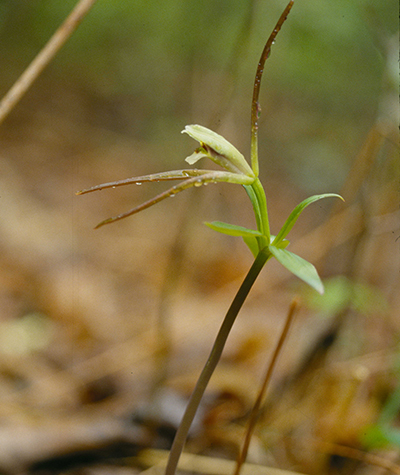Large Whorled Pogonia

Photo: Loyal A. Mehrhoff
Species information
This chapter provides a review of progress towards the protection and recovery of Large Whorled Pogonia in Ontario from 2007 to 2017.
Large Whorled Pogonia (Isotria verticillata) is an orchid with a single yellowish-green flower that grows above a whorl of green leaves and can attain a height of 30 centimetres. It lives in moist, deciduous or mixed forests with a semi-open canopy on sandy acidic soil with thick leaf litter and abundant humus. Like many orchids, this species has a symbiotic association with mycorrhizal fungi in the soil, upon which it depends for nourishment. As it can remain dormant underground for many years, it may persist undetected for long periods, possibly decades. Large Whorled Pogonia may be found at only a few locations in the Carolinian forests in southwestern Ontario. Although the last recorded observation of this species in Ontario was in 1996, it is presumed to still exist at two locations, and possibly at a third. It has never been known to be common in the province, although historical surveys may have been limited.
The species faces several threats to its survival and recovery, including habitat loss or degradation due to land clearing, incompatible forestry practices, trampling, flooding, the effects of atmospheric pollutants and invasive plant species (e.g. Garlic Mustard (Alliaria petiolata)). Clearing of forests for development can eliminate habitat altogether, damage it by drying the humus layer and enabling exotic and invasive species to establish, and cause fragmentation and isolation of remaining Large Whorled Pogonia populations.
The survival and recovery of Large Whorled Pogonia are influenced by other factors as well, including geographic isolation, small population sizes, and its highly specialized reproductive biology. As the populations are small and isolated, the species is at risk of being destroyed by stochastic events such as major storms, drought or wildfire. Loss of genetic diversity is also a concern as it occurs in such small, geographically isolated populations.
Large Whorled Pogonia is listed as endangered at both the provincial level (Species at Risk in Ontario List) and federal level (Schedule 1 under the Species at Risk Act). Globally, it is considered to be secure (NatureServe Explorer).
Provincial status
Prior to the Endangered Species Act, 2007 (ESA or “the Act”), the Committee on the Status of Species at Risk in Ontario (COSSARO) assessed Large Whorled Pogonia as endangered, and it was regulated under the previous Endangered Species Act in 1987. COSSARO reassessed Large Whorled Pogonia in 2011 and reconfirmed its status as endangered. Large Whorled Pogonia continues to be listed as endangered under the ESA. In future assessments, COSSARO may consider information gained through protection and recovery actions regarding the species’ threats and trends in population and distribution.
Species and habitat protection
Protecting Large Whorled Pogonia and its habitat are key components in the implementation of the ESA, and continue to be government-led actions, as identified in the government response statement (GRS). As a species that was regulated under the previous Endangered Species Act, Large Whorled Pogonia has received species and habitat protection since 1987 and retained these protections under the ESA. The Act prohibits the species from being killed, harmed, harassed, captured or taken and its habitat from being damaged or destroyed. Habitat protection for the species is based on the general habitat definition in the Act. The ESA does not require a habitat regulation to be developed for transition
Any person who negatively impacts Large Whorled Pogonia or its habitat without prior authorization or through the use of a regulatory exemption may be prosecuted under the ESA.
Large Whorled Pogonia has been protected from being killed, harmed, harrassed, captured or taken since 1987.
In addition, the habitat of Large Whorled Pogonia has been protected from being damaged or destroyed since 1987.
Recovery strategy
A recovery strategy for Large Whorled Pogonia was published on June 15, 2012, which was in advance of the date required by the ESA. Recovery strategies are advice to government and represent the best available scientific knowledge. The strategy identifies the habitat needs of the species and the threats that it faces, while recommending objectives and approaches for its protection and recovery. The recovery strategy also includes recommendations on the areas of habitat to be considered in the development of a habitat regulation.
Government response statement
The government published the GRS for Large Whorled Pogonia on May 31, 2013. The GRS is the Government of Ontario’s species-specific policy on what is needed to protect and recover a given species, and includes the associated recovery goal.
To help achieve this goal, the government leads, supports and prioritizes recovery actions identified in the GRS. Common actions for the government to lead as it works towards achieving a species’ recovery goal are provided in section 2.5 of the Species at Risk Program Status (2008-2015). An action in the GRS for the government to lead that is specific to this species, and not included in the typical actions in section 2.5 is:
- Develop a survey protocol to be used by proponents and partners to survey for the presence of Large Whorled Pogonia.
Recovery Goal
The government’s goal for the recovery of Large Whorled Pogonia is to confirm its presence and maintain the persistence of the species' populations and habitats in southern Ontario.
The GRS for Large Whorled Pogonia also lists four actions the government supports others to undertake for the species. These government-supported actions fall under the objectives identified in the GRS, which are:
- Confirm the existence of Large Whorled Pogonia populations and determine their extent and abundance;
- Protect and manage habitat to maintain existing populations in Ontario; and
- Increase awareness about the significance, uniqueness and vulnerability of the Large Whorled Pogonia.
Ontario’s Invasive Species Act
The GRS for Large Whorled Pogonia indicates that invasive species (e.g. Garlic Mustard) pose a threat to the survival and recovery of the species in Ontario. The Ontario Invasive Species Strategic Plan, 2012 and the Invasive Species Act, 2015 provide the policy and legislative framework to support the prevention, detection and control of invasive species in Ontario. This framework may support actions to reduce the threats of invasive species.
Government-funded projects
An important government-led action in the GRS for Large Whorled Pogonia is to support partners to undertake activities to protect and recover the species. Through the Species at Risk Stewardship Program the government has supported four projects ($337,392) designed to contribute to the protection and recovery of Large Whorled Pogonia. All of these projects targeted multiple species at risk, including Large Whorled Pogonia, and partners reported that they were successful in securing additional funding ($159,867) from other sources. This amount includes in-kind support in the form of time and expertise provided by volunteers.
Stewardship partners reported that provincial funding helped them to secure in-kind support by involving 184 individuals who volunteered 2,534 hours of their time towards protection and recovery activities for multiple species at risk, including Large Whorled Pogonia, which has an estimated value of $70,995. In addition, stewardship partners reported providing ecosystem-based outreach focused on multiple species, including Large Whorled Pogonia, to 2,500 individuals.
The remainder of this section highlights one project supported through the Species at Risk Stewardship Program as well as the corresponding government-supported recovery actions for the species.
In 2009, Earth Tramper Consulting Inc. received funding from the Species at Risk Stewardship Program to conduct detailed ecological surveys of the plants, insects and breeding bird populations at risk in Backus Woods, Norfolk County. This 560 acre property, owned by the Nature Conservancy of Canada (formerly part of the Long Point Region Conservation Authority), is managed in a manner intended to promote the return of mature deciduous forest. These ecological surveys were proposed as follow up to a series of surveys that were originally conducted in 1985, as a means of determining how species composition and diversity has changed and the current status of the species at risk populations in Backus Woods.
Vegetation surveys involved locating the original plot grids that existed from the 1985 vegetation surveys, and re-surveying and taking a GPS location of the circular quadrats at a portion of those sites to compare plant species at risk and species of conservation interest between 1985 and 2009. Additional vegetation surveys were conducted to assess the presence/absence of taxa (i.e., groups of species) observed in 1985 and to search for target species identified as priority plants by the government.
The plant surveys identified 12 new species in the Backus Woods compared to 1985, indicating that species richness has increased. However, as many as 10 other species have apparently been extirpated from the area, including Large Whorled Pogonia (although owing to the later initiation date of the field survey in 2009, it is possible the species did occur but was not observed), and the number of non-native species has increased. The results from the survey informed recommendations to maintain the natural heritage features and values associated with Backus Woods.
This project supports the GRS actions associated with determining if the species is present and if so, the abundance of Large Whorled Pogonia populations.
Voluntary landowner participation to protect Large Whorled Pogonia
Encouraging stewardship of Large Whorled Pogonia, including participation in the Conservation Land Tax Incentive Program (CLTIP) and the Managed Forest Tax Incentive Program (MFTIP), is a high priority government-supported action in the GRS. CLTIP is a voluntary program providing an incentive for landowners, including charitable conservation organizations and conservation authorities, to protect conservation lands that include eligible natural heritage features, such as the habitat of species at risk. CLTIP offers 100 percent property tax exemption on eligible portions of a landowner’s property for the annual (long-term) commitment to the protection and stewardship of conservation lands. From 2008 to 2017, one private property and two properties owned by conservation organizations with Large Whorled Pogonia participated in CLTIP, protecting approximately 160 hectares of habitat. Landowner participation in CLTIP supports the protection and management of natural populations of Large Whorled Pogonia and their habitats.
Species at Risk Stewardship Fund
-
 4
4projects included Large Whorled Pogonia
-
 $337,392
$337,392for multi-species projects that included Large Whorled Pogonia
-
 $159,867
$159,867in additional funding and in-kind support
-
 184
184volunteers
-
 2,534
2,534volunteer hours
-
 2,500
2,500people received outreach
Efforts to minimize adverse effects on Large Whorled Pogonia
Supporting partners through permits and their associated conditions is an important government-led action. To date, no permits have been issued for Large Whorled Pogonia.
Two activities that may affect Large Whorled Pogonia or its habitat have been registered for the purposes of the Ontario Regulation 242/08 under the ESA. This includes one activity registered under ‘Drainage works’ (section 23.9), and one activity registered under ‘Threats to health and safety, not imminent’ (section 23.18) of Ontario Regulation 242/08. The registrations require the registered individual to comply with all conditions of the regulation, such as:
- Take reasonable steps to minimize adverse effects of the activity on the species identified in the notice of drainage work form;
- Prepare a mitigation plan using best available information on steps that may help minimize or avoid adverse effects on the species; and
- Report observations of the species using the Ontario Species at Risk Observation Reporting Form and submitting it to the Natural Heritage Information Centre (NHIC).
-
2registrations
Occurrences of Large Whorled Pogonia in Ontario
Four populations
Since 2008, the government’s central repository at the NHIC has received six records of the species. These records are based on observations between 1989 and 1993 and come from the government. Records submitted have helped to refine where the species is known and has been known to occur and can provide additional information on the species’ habitat and threats.
Records of Large Whorled Pogonia date back to 1879, and the NHIC received 29 observations between 1879 and 1996. There have been no observations since 1996. The Skunk’s Misery population was considered extant in 2017, but the viability status changed from extant to historical in 2018 given the last observation was in 1996 and negative search results in 1997.
It is possible that there are observations of Large Whorled Pogonia that have not been submitted to the government. Encouraging the submission of observations of Large Whorled Pogonia to the government is included in the GRS as a government-led action. Submission of species observations to the government increases our knowledge of where they occur and can play an important role in assessing the viability of species populations.
Everyone is encouraged, or may be required by an authorization or approval, to submit observations of Large Whorled Pogonia, and any other species at risk observed, to the government’s NHIC for incorporation into the provincial record of observations.
6 observations of this species were submitted to the NHIC since 2008
Summary of progress towards meeting the recovery goal
Summary of progress
Progress has been made towards the majority of the government-led actions and the majority of the government-supported actions outlined in the GRS for Large Whorled Pogonia. The Government of Ontario has directly undertaken actions to:
- Educate other agencies and authorities involved in planning and environmental assessment processes on the protection requirements under the ESA
- Encourage the submission of Large Whorled Pogonia data to the government’s central repository at the NHIC
- Undertake communications and outreach to increase public awareness of species at risk in Ontario
- Protect Large Whorled Pogonia and its habitat through the ESA
- Support conservation, agency, municipal, industry partners and Indigenous communities to undertake activities to protect and recover the Large Whorled Pogonia. Support will be provided through funding, agreements, permits (including conditions) and advisory services
- Establish and communicate annual priority actions for government support in order to encourage collaboration and reduce duplication of efforts
Government-supported actions are organized under overarching recovery objectives. Progress has been made towards two of the government-supported recovery objectives and three of the associated actions identified in the GRS for Large Whorled Pogonia.
Under the objective to confirm the existence of Large Whorled Pogonia populations and determine their extent and abundance, initial progress has been made towards Action No. 1.
- Conduct surveys for Large Whorled Pogonia at the sites where it may currently exist and, if found, document information about the population levels and demographics, its habitat, and any threats that may be present (Action No. 1 – High Priority).
This action has been implemented through a project supported by the Species at Risk Stewardship Program, which conducted an inventory of species at risk in a historic site where Large Whorled Pogonia had been previously documented.
Under the objective to protect and manage habitat to maintain existing populations in Ontario, progress has been made towards the single action.
- Encourage stewardship activities to reduce threats to the species and its habitat at the sites where it may currently exist by maintaining suitable habitat conditions, removing invasive species, and reducing pedestrian traffic near occurrences (Action No. 3).
This action has been implemented through projects supported by the Species at Risk Stewardship Program. These projects were focused on stewardship activities to increase awareness and educate landowners and other sector representatives about threats and mitigation strategies for populations and habitats of multiple species at risk, including Large Whorled Pogonia.
Under the objective to increase awareness about the significance, uniqueness and vulnerability of the Large Whorled Pogonia, initial progress has been made towards Action No. 4.
- Provide information to orchid enthusiasts and other key stakeholders regarding the risks to Large Whorled Pogonia from inadvertent trampling and collecting (Action No. 4).
This action has been implemented through projects supported by the Species at Risk Stewardship Program. These projects were focused on researching traits and risk factors for orchid species at risk, including Large Whorled Pogonia, that make some species more vulnerable to natural and anthropogenic disturbance than others, and to spread awareness about reducing threats to populations and habitats of multiple species at risk.
The recovery goal for Large Whorled Pogonia is to confirm its presence and maintain the persistence of the species' populations and habitats in southern Ontario. Effort made towards the government-led and government-supported GRS actions has helped to make progress towards this goal for the Large Whorled Pogonia. Although Large Whorled Pogonia has not been observed since 1996, stewardship partners have conducted surveys to assess species presence and promoted activities to maintain habitat and reduce threats for Large Whorled Pogonia and other species at risk that occur in similar habitat types.
Recommendations
As stated in the GRS, the review of progress towards protecting and recovering Large Whorled Pogonia can be used to help identify whether adjustments are needed to achieve the protection and recovery of the species. Based on progress to date, the overall direction provided in the GRS for Large Whorled Pogonia should continue to guide protection and recovery actions for the species, particularly for those actions identified as high priority in the GRS. Relative to actions that have received a higher level of support, the following actions have received less support and may be prioritized in future activities and associated decisions regarding the protection and recovery of the species:
- Develop a survey protocol to be used by proponents and partners to survey for the presence of Large Whorled Pogonia (a government-led action)
- Conduct surveys for Large Whorled Pogonia at the sites where it may currently exist (Action No. 1 – High Priority)
- Conduct surveys at locations with potentially suitable habitat to determine if Large Whorled Pogonia is present (Action No. 2)
Although initial progress has been made, further work is required to fully implement increasing awareness about the risks to Large Whorled Pogonia from inadvertent trampling and collecting (Action No. 4).
Moving forward, protecting and recovering Large Whorled Pogonia will continue to be a shared responsibility that will require the involvement of many individuals, organizations and communities. Financial support for the implementation of actions may be available through the Species at Risk Stewardship Program. The government can also advise if any authorizations under the ESA or other legislation may be required to undertake a project. By working together, progress can continue to be made towards protecting and recovering Large Whorled Pogonia in Ontario.
Summary of progress towards the protection and recovery of Large Whorled Pogonia (2007 to 2017)
Provincial status
Large Whorled Pogonia is classified as endangered under the Endangered Species Act, 2007 (ESA). Large Whorled Pogonia was also listed under the previous Endangered Species Act, and has retained the same status since transition to the ESA. Large Whorled Pogonia has received species and habitat protection since1987.
Species-specific documents and guidance published by the government
- Recovery Strategy for Large Whorled Pogonia (2012)
- Large Whorled Pogonia: Ontario Government Response Statement (2013)
Government-supported stewardship projects
- Through the Species at Risk Stewardship Program, the Government of Ontario has enabled its stewardship partners to conduct four projects ($337,392) that have supported the protection and recovery of multiple species at risk, including Large Whorled Pogonia.
- The government’s support helped its stewardship partners to involve 184 individuals who volunteered 2,534 hours of their time towards protection and recovery activities for species at risk, including Large Whorled Pogonia. The estimated value of these voluntary contributions, as well as additional funding and in-kind support, is approximately $159,867.
- Stewardship partners reported providing outreach on multiple species at risk, including Large Whorled Pogonia, to 2,500 individuals.
Supporting human activities while ensuring appropriate support for species recovery
- Two activities have been registered for the species. The activities were registered under ‘Drainage works’ (section 23.9) and under ‘Threats to health and safety, not imminent’ (section 23.18) of Ontario Regulation 242/08 of the ESA.
Occurrences and distribution
- Four populations of Large Whorled Pogonia have been documented in the Carolinian woodlands of southwestern Ontario. Currently, none of these populations are known to be extant; three are considered historical and one is considered extirpated. Since 2008, the status of one population changed from extant to historical based on the date that it was last observed. Despite surveys for the species as recently as 2009, there have been no observations of Large Whorled Pogonia since 1996.
References
- Categorizing and Protecting Habitat under the Endangered Species Act
- Natural Heritage Information Centre
- Ontario’s Endangered Species Act
- Ontario’s Endangered Species Act Regulation 242/08
- Ontario Recovery Strategy and Government Response Statement for Large Whorled Pogonia
- Policy Guidance on Harm and Harass under the Endangered Species Act
- Species at Risk in Ontario List
- Species at Risk Stewardship Program
Footnotes
- footnote[1] Back to paragraph A transition species, for the purposes of this report, is an endangered or threatened species listed under schedule 1, 3, or 4 of the ESA that has not changed in status since June 2008.
- footnote[2] Back to paragraph A population is defined as an area of land and/or water on/in which an element (e.g., Large Whorled Pogonia) is or was present. They are comprised of one or more observations and the area has a practical conservation value as it is important to the conservation of the species. An element occurrence is the technical term used to describe this.
- footnote[3] Back to paragraph A population is considered historical if it has not been recorded within the last 20 years. Historical populations may still exist, but updated information is not available. and one is considered to be extirpated.